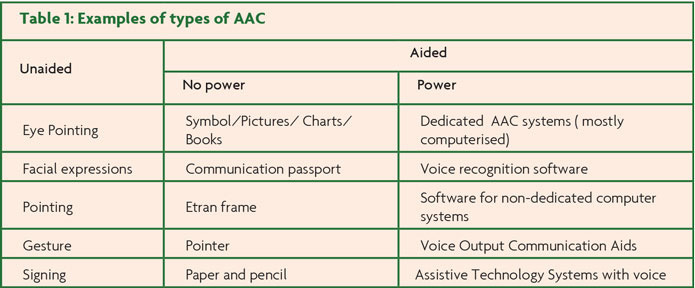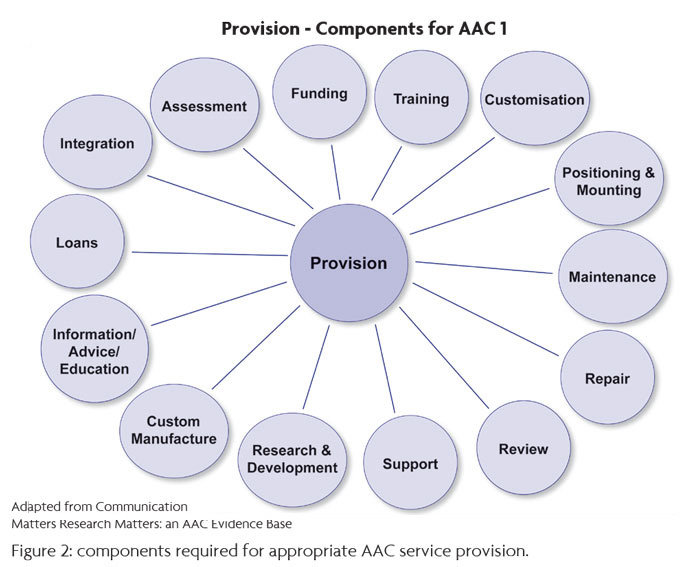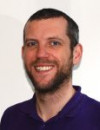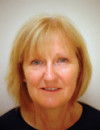People of all ages with severe speech, voice and language impairments use a range of Augmentative and Alternative Communication (AAC) methods to assist them communicate their views and needs. AAC includes non technological systems such as signing, use of symbols and picture charts as well as sophisticated technology including dedicated computerised systems and voice output communication aids. Without these systems people with communication difficulties are unable to realise their potential and face social isolation, dependency and a decreased quality of life which can lead to increased care costs.
The project summarised here was funded by the Big Lottery through Communication Matters a charity dedicated to supporting those who have difficulty in expressing themselves verbally and who require augmentative and alternative methods of communication (AAC).
Objectives of this research
- To investigate evidence of need for Augmentative and Alternative Communication (AAC) i.e. how many people would benefit?
- To map the provision of services in the UK for AAC. Identify the numbers and types of services in the UK, their funding arrangements and types of service provision.
Research methods
In order to investigate the need for AAC several methods were used including:
- Identifying literature related to the prevalence of conditions which would benefit from AAC.
- Inspecting two National databases to determine information of relevance.
- Gathering data from AAC users (including dissatisfied users), carers, a range of health, social care and teaching professionals, charities and suppliers. This data was gathered through focus groups, interviews (both face-to-face and by telephone), survey questionnaires (both paper and Internet-based).
Topic sheets and interview questions were informed by the literature and modified iteratively through the course of the study in order to elicit issues raised at different stages in the research.
Literature review
All aspects of the study were informed by a broad ranging literature review (Baxter S, Enderby P, Evans P, Judge S 2012). A large number of databases (8) were reviewed and initially identified 2883 papers. Of these, 299 were accessed and scrutinised. One hundred and forty-one were found to be relevant to this study and included in the review. The key points from the literature are identified below.
Key Point 1: only three studies identified in the systematic review of AAC interventions included more than ten individuals.
Key Point 2: there are many references in the literature related to funding difficulties for the provision of high-tech equipment which is coming onto the market.
Key Point 3: the range of AAC for persons with language rather than motor speech disorders is increasing.
Key Point 4: whilst limited, the evidence of benefit for patients by providing AAC is clear.
Key Point 5: outcomes are not consistently reported making the pooling of data difficult.

Need and impact of AAC
The population of individuals requiring and benefiting from AAC is heterogenous and changing. Medical successes have led to a larger proportion of children with severe disabilities and those with acquired injuries such as head injury surviving for longer. Furthermore, the population is becoming older with the associated increase in complex conditions and acquired neurological disease e.g. Parkinson’s disease being represented.
Key point 6: the few papers reporting demographic information relating to AAC provide different figures suggesting variation in access to services.
Key point 7: devices can augment natural speech or writing, or can be utilised as an alternative to spoken utterances or writing which is required for supporting certain conditions.
Key point 8: the evidence of the impact of AAC from the literature is mostly limited to low-tech devices and provides little information which would facilitate generalisation to broader populations or knowledge of longer term maintenance and usage.
Key point 9: case and group studies indicate that AAC has been found to be useful in expanding the communication of many patients with broad range of underlying conditions affecting their communication potential. The complexity of the multifactorial impairments and frequently associated cognitive, sensory and environmental situations has an impact on study design and generalisability of the findings.
Key point 10: research, reported in the literature, comparing an individual’s usage of different devices provides useful information regarding preferences and usage.
Key point 11: the majority of studies have indicated the importance of identifying the right AAC approach within the context of a service offering a programme of support and teaching for users and carers to maximise usage.

Epidemiology: Having an estimate of the numbers of individuals requiring services is necessary for the development of services and the commissioning of such. These numbers will also assist in identifying unmet need and benchmarking of provision. However, there are several reasons why it is difficult to make precise estimates of need.
Key point 12: the report of the Communication Champion (ref. 3) identified substantial variation in the provision of AAC services across the country which is confirmed by our research.
Key point 13: there is a highly dynamic policy and economic background to the data collection carried out in this project. This undoubtedly affected the data collection and nature of the data collected from participants. However, it also allowed for a direct and responsive link between the research and the policy and campaigning action.
Key point 14: Identifying the numbers of individuals requiring AAC services is important for planning but is challenging given changing demography and rapidly increasing sophisticated technology.
Data sources
Existing data sources were identified as the General Practice Research Database (GPRD) and the English Health Survey. These sources were searched to provide information about statistics relevant to need for AAC. This data was put into the context of qualitative information gathered from users, professionals and others and subject to a validation exercise with respondents generating and ranking most common aetiologies requiring AAC services. Questionnaire and survey methods were used to gather information from practitioners, suppliers and charities.
Key point 15: Estimating the need for AAC incorporated three methods: inspecting the GPRD database, examining the results of the Health Survey for England, deducting prevalence from the literature, and survey methods and validating information by questioning experts.
Key point 16: 0.5% of the population are estimated to require AAC. This equates to 529 people per hundred thousand population. The population of potential AAC users has a broad range of complex conditions with different underlying medical diagnoses.
Key Point 17: 97.5% of the total number of people who could benefit from AAC have the top 9 conditions. The 2 conditions that represent 45.9% of that population consist of Alzheimer’s/Dementia and Parkinson’s disease, conditions associated with an older population where amenable technologies are becoming more available but distribution and use are lagging behind.
Key Point 18: the validation exercise showed that there was some difference between the perception of AAC use and the estimated need calculated from conditions. Of particular note is the discrepancy relating to Alzheimer’s disease and Parkinson’s disease which is possibly related to the lack of knowledge relating to new technologies.
Key point 19: new technologies which can be accessed by individuals with more complex cognitive, physical, sensory and communication deficits are being developed and trialled in research but are not easily available to those with these needs.
Provision of AAC in the UK
Surveys, interviews and site visits investigated current provision, service models and views of practitioners. Surveys and interviews with AAC users and communication partners explored their experience of service provision.
Key point 20: 38 AAC users responded to the survey. Most had heard about the research through the charity Communication Matters. The gender split was relatively even with only one of the responders being below the age of 18. The responders reported a broad range of communication strategies and experience of AAC device use.
Key point 21: 36 communication partners responded to the survey. Most were family members and all but one had English as their first language.
Key point 22: the qualitative data identified a number of components that were required for effective service provision of aided-AAC and the ongoing use of aided-AAC. The service components are: assessment, information and advice, loans, positioning and mounting, customisation, funding, maintenance, repair, review of needs, support, integration, research and development.
Service components were defined using a Delphi technique to assist with clarifying requirements of provision (see figure 2). Within each component there are different elements of activity e.g. Assessment incorporates: Identification of need, formal and informal assessment of physical and cognitive abilities, access requirements, needs and wishes of individual and their carers, environmental facilitators and barriers, identification of communication partners and their needs, training and support requirements, matching the device to the person etc. A full list of the components required for AAC provision is detailed in the final report.
Key point 23: there was consensus between professionals, AAC users and communication partners that the service components were all required to facilitate effective identification, provision and use of AAC. Figure 2: components required for appropriate AAC service provision.

Key point 24: whilst most AAC users and partners expressed that they received sufficient support, timing and training in choosing a communication aid this was not the experience of all, with some expressing significant dissatisfaction.
Key point 25: there was consensus between professionals, AAC users and communication partners that all of the service components were required to facilitate effective identification and use of AAC.
Key point 26: Service providers emphasised that some aspects/components of their service were more important, more achievable, more available and reported different levels of satisfaction expressed by service users and their carers with different aspects of the provision.
Service models
The provision of the services for aided-AAC rests with different providers including: the health service, local authority, educational authority, charitable organisations, and personal accounts. The study found a number of different models and types of provision of AAC in the way it was funded, skill mix, facilities and equipment.
Key point 27: the numbers of staff, skill mix and methods of working are unique to each team both locally and in specialist services.
Key point 28: there is no consistency in the elements/components of service provision of either local or specialist services in the UK.
Key point 29: many services have developed innovative methods to identify, assess and provide ongoing support to AAC users, communication partners and other relevant staff.
Key point 30: funding arrangements for services and equipment was the issue of concern most commonly raised by professionals, AAC users and communication partners. Lack of consistent arrangements for maintenance and replacement of AAC devices and a lack of clarity and consistency was the experience of most.
Key point 31: continuing support for developing communication skills through use of AAC varied by services and the age of the person. The lack of on-going support particularly for adults was raised by professionals, AAC users and communication partners.
Experience of services
AAC users, their family members and carers provided information through interview and survey regarding their experience of services. Frustration was expressed relating to time taken to identify that they would benefit, funding difficulties and lack of support. It was particularly disappointing that there were many more negative comments relating to speech and language therapy involvement than positive comments.
Key point 32: whilst many users and carers expressed satisfaction, more expressed frustration with all or some part of the service. Of particular note was the lack of technical skills and knowledge of speech and language therapists.
Service categorisation
The levels and types of services needed to be defined in order to reflect provision to this population.
A specialised service for AAC requires a set of resources and skills that can cater for the most complex needs of an individual requiring AAC and related services. The definition and components of specialist services has been built up taking information from the Draft Specification for Specialised AAC Services (currently under consultation) and using the data collected in the practitioners’ survey in order to categorise and map service provision across the UK.
The definition determined that a specialised service provides:
- Assessment
- Loan for trial
- Provision of powered aid
- Maintenance
- Customisation of equipment (particularly hardware)
- Training for professionals
They are usually staffed with an interdisciplinary team with the following competencies:
- Electronic assistive technology (clinical scientists, clinical technologists, rehabilitation engineer, assistive technologists or equivalent);
- Speech and language therapist with specialism in AAC;
- Learning and educational development competence for those clients in education (teacher);
- Seating, positioning, mounting of equipment and access and control methods (physiotherapist or occupational therapist);

Key point 33: service provision was found to be distinctly different across the country with different levels of satisfaction expressed by service users and their carers with different aspects of the provision.
Key point 34: there is no consistency in the elements of service provision of either local or specialist services in the UK.
Key point 35: less than 5% of services responding to the survey reported joint funding arrangements for the provision of their service.
Key point 36: the majority of services cover an area equivalent to a local authority or NHS trust/board area with less than 20% of those surveyed covering a wider area.
Key point 37: a broad range of eligibility criteria are used by different services resulting in variable access to services.
Funding from the Big lottery through a charity for this research has given us opportunities to undertake work that otherwise would probably have not been undertaken.
This research required a multimethod approach and it is unlikely to have attracted funding from traditional research bodies. Collaboration with a broad number of partners (AAC users, communication partners, a broad range of health and education staff, and industry) was facilitated by working with Communication Matters. Being able to attend the conferences organised by this charity offered opportunities to facilitate the validation of findings, further exploration of issues and identify priorities. We are pleased that the research is assisting in identifying requirements in order for providers to consider their services and detail business plans for central commissioning which, we hope, will improve equity of access and reduce variation of services.
The authors are grateful to members of Communication Matters particularly Janice Murray, Katie Holmes and David Mason for their support and assistance with this project.
References
- Baxter S, Enderby P, Evans P, Judge S. Interventions using high-technology communication devices: a state of the art review. Folia Phoniatrica Logopaedia 64(3):137-144 2012
- The Bercow Report: A Review of Services for Children and Young People (0-19) With Speech Language and Communication Needs, 2008
- Specialised AAC provision, commissioning national services, Office of the Communications Champion and Council, November 2011



